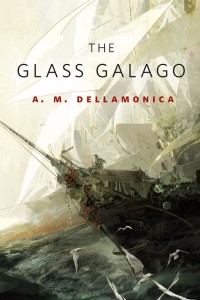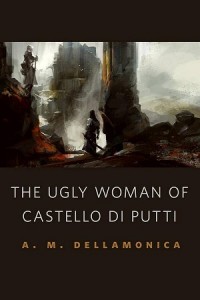In 1995, I went to the Clarion West writing workshop, where Gardner Dozois made a passing remark about how many fantasy and SF worlds created by newer writers, were comparatively simple, politically. He was describing a one planet, one government, one language, one culture kind of formula. He used a phrase like “failure to fully imagine a settomg…”
It was an observation, not a rant or a lecture; I doubt more than one breath went into it. But it set me back on my heels a little. There was a “Oh, yeah!” moment. Since then, I’ve taken that throwaway remark as license to write complicated, messy worlds filled with different tribes, factions and languages.
I tell you this because Paul Weimar of SF Signal asked: What were your inspirations for the various cultures we see in Child of a Hidden Sea ?
?
Pick an Island, Add Magic
There are about 250 island nations on Stormwrack, so I thought I’d start with Erinth. (At some future point, if you’re all interested, I’ll do entries on Verdanni and Sylvanna. Not until after the book’s out, though, when it’s less spoilery.)
A lot of us get our early image of spellcasting and magic from depictions of warty, cackling crones over a cauldron, dumping eye of newt and fillet of a fenny snake into a cauldron as they chant, “Bubble babble, toil and trouble, let’s trick MacBeth into making some bad choices. Evil Magic Soup FTW!”
I wanted Stormwrack to have a wisp of this–specifically, the eye of fenny snake element–in its magic system. Each of those 250 island nations has its own microclimate, and the specific types of newt, toad and creeping kudzu available to a people determines what kind of spells they can work with it. In one archipelago, you might have five islands with seven variations of newt and seven completely different resulting magical effects.
To this foodie-influenced cooking element, I added contract law. The spellscribe has an intention, you see. They want to make you beautiful or restore your lost hearing or give you angel wings or help you do lightning-fast calculations in your head or cause you to keel over dead. They cook up their ingredients, usually following a recipe set out by earlier researchers. They write the precise text of the spell, using a magical language with its own magical alphabet. The spellscrip has been imagined here by cover artist, Karla Ortiz–there’s some on the sails of Nightjar, on the Child of a Hidden Sea cover.
cover.
The spell must be written with specific materials, on other specific materials. It’s an exercise in perfection. Get it wrong–imprecise materials, flawed writing surface, misform a letter wrong as you’re engaged in calligraphy–and nothing happens. That newt died for nothing. Get it just right, though, and you have a form of magical contract. The nature of reality is changed…
… for as long as the physical artifact, the inscription, remains intact.
That’s right. Spells are, on Stormwrack, things you can literally break. Destroy the contract, the spell doesn’t necessarily fizzle. Reality reasserts itself as best as it can. If you had a magical appendectomy twenty years ago and somebody rips up your scroll, you might get your appendix back, inflamed and ready to pop. Then again, if the appendix has been sitting pickled in a jar for twenty years, you might get that, formaldehyde and all.
Tame a volcano? What could go wrong?
This brings us to Erinth. One of my earliest notes on Stormwrack was a long list of possible spells, which said, “there’s an island that uses magic to hold the local Santorini-like volcano in check…”
Say you’re the Conto of an island whose population is tired of having the neighborhood volcano wipe out the capital city, or a substantial portion thereof, every sixty years or so? Say you set all the magicians you can afford on researching a way to write an intention that will calm the mountain down.
Cindria, Erinth’s capital, lives in the shadow of a volcano calmed by such an intention. It’s described here, in “The Ugly Woman of Castello di Putti .”
.”
“See for yourself.” Tonio swept out an arm as they reached the cliff top, and Parrish saw the figure of a woman, sculpted in rose marble and fully fifty feet high. Clad in a modest robe, hair bound at the nape of her neck, she stood on the inland lip of the caldera, hands out in a soothing gesture, the hushing pose of a mother calming a child in its cradle.
Ice-blue spellscrip glimmered on her arms and hands, written from shoulder to fingertip.
In the shadow of those big stone hands, the molten stone churned like a pot aboil. Beyond it, the flow of lava seemed orderly and civilized.
One obvious inspiration here, then, is nature in the form of my favorite volcanos: Mount Saint Helens, or Santorini, to name two.
I had already decided this much about Erinth before a trip to Italy in 2012. Since I was going, I went to Catania to see black lava buildings, not to mention Mount Etna. I went to Naples to see Vesuvius and one of the cities, Herculaneum, that it destroyed in 79.
Erinthians live in the shadow of a killer mountain, and they know that when something finally happens to their Lady, all the stored energy from all those becalmed eruptions will come bursting forth in spectacular fashion. They deal with this reality in a very human way–by posting guards around the statue and hoping for the best. If it weren’t for the time honored concept best articulated by the phrase of “La la la, I can’t hear youuuuu,” most of us would spend all our waking hours in the fetal position.
Having taken a bit of inspiration from the landscape of Italy and the history of Santorini, I married the terrain to another of my early notes on politics, which read “…there’s an island a bit like Florence under the Medicis.”
You might say my approach to worldbuilding is additive. I’m not quite as much of an extrapolator: “If this happens, then naturally the people will worship this kind of god and develop that kind of technology…” I admire people who do that and make it seem effortless. I’m more of a pinch of this, dash of that, see how it tastes, add something else kind of writer. I’ve got the magic figured out? Yay! Now I’ll add the volcano. Got the volcano tamed? Let’s add some Renaissance Florence! How does that all work? Oh, there’s some extrapolating, I suppose. They’ve got the tame volcano, so maybe there’s a local industry in volcanic glass. And pumice. Maybe pumice figures into beauty spells?
As I write this, there is just over a month days before Child of a Hidden Sea ‘s release date. I don’t think it’s much of a spoiler to say we’ll be going back to Erinth for awhile over the course of the novel. It’s one of Gale Feliachild’s favorite places, a place where she feels truly at home. Naturally, I hope all of you enjoy being there and getting to meet the older versions of Tonio, Secco and some of the other characters from the above-mentioned story.
‘s release date. I don’t think it’s much of a spoiler to say we’ll be going back to Erinth for awhile over the course of the novel. It’s one of Gale Feliachild’s favorite places, a place where she feels truly at home. Naturally, I hope all of you enjoy being there and getting to meet the older versions of Tonio, Secco and some of the other characters from the above-mentioned story.

” and “The Ugly Woman of Castello di Putti”
.) This new story takes Gale Feliachild and Garland Parrish to the Fleet itself. It’s not the first visit for either of them, obviously, but it’s their first time together. Gale learns a little more about what it was that got Garland disgraced and kicked out of the service. I hope you guys like it.



